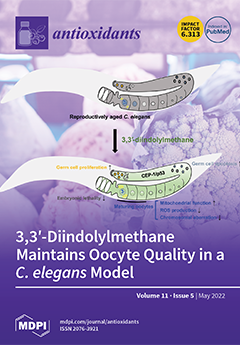Alpinia oxyphylla Miq. (Zingiberaceae) extract exerts protective activity against
tert-butyl hydroperoxide-induced toxicity in HepG2 cells, and the antioxidant response element (ARE) luciferase activity increased 6-fold at 30 μg/mL in HepG2 cells transiently transfected with ARE-luciferase. To identify active molecules, activity-guided isolation of
[...] Read more.
Alpinia oxyphylla Miq. (Zingiberaceae) extract exerts protective activity against
tert-butyl hydroperoxide-induced toxicity in HepG2 cells, and the antioxidant response element (ARE) luciferase activity increased 6-fold at 30 μg/mL in HepG2 cells transiently transfected with ARE-luciferase. To identify active molecules, activity-guided isolation of the crude extract led to four sesquiterpenes (
1,
2,
5,
6) and two diarylheptanoids (
3 and
4) from an
n-hexane extract and six sesquiterpenes (
7–
12) from an ethyl acetate extract. Chemical structures were elucidated by one-dimensional, two-dimensional nuclear magnetic resonance (1D-, 2D-NMR), and mass (MS) spectral data. Among the isolated compounds, eudesma-3,11-dien-2-one (
2) promoted the nuclear accumulation of nuclear factor (erythroid-derived 2)-like 2 (Nrf2) and increased the promoter property of the ARE. Diarylheptanoids, yakuchinone A (
3), and 5′-hydroxyl-yakuchinone A (
4) showed radical scavenging activity in 2,2-diphenyl-1-picrylhydrazyl (DPPH) and 3-ethylbenzothiazoline-6-sulphonic acid (ABTS) assays. Furthermore, optimization of extraction solvents (ratios of water and ethanol) was performed by comparison of contents of active compounds, ARE-inducing activity, radical scavenging activity, and HepG2 cell protective activity. As a result, 75% ethanol was the best solvent for the extraction of
A. oxyphylla fruit. This study demonstrated that
A. oxyphylla exerted antioxidant effects via the Nrf2/HO-1 (heme oxygenase-1) pathway and radical scavenging along with active markers eudesma-3,11-dien-2-one (
2) and yakuchinone A (
3).
Full article


